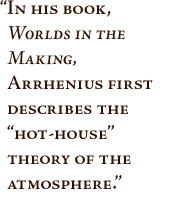

During the next ten years, Arrhenius continued his work on the effects of carbon dioxide on climate, and published a two-volume technical book titled Lehrbuch der kosmischen Physik in 1903; but this work was not widely read, as it was a textbook for a discipline that did not yet exist. A few years later, Arrhenius published Worlds in the Making, a non-technical book that reached a greater audience. In this book Arrhenius first describes the “hot-house theory ”of the atmosphere, stating that the Earth's temperature is about 30 degrees warmer than it would be due to the“ heat-protection action of gases contained in the atmosphere,”a theory based on ideas developed by Fourier, Pouillet, and (especially) Tyndall. His calculations demonstrated that if the atmosphere had no carbon dioxide, the surface temperature of the Earth would fall about 21 degrees Celsius, and that this cooler atmosphere would contain less water vapor, resulting in an additional temperature decrease of approximately 10 degrees Celsius. It is important to note that Arrhenius was not very concerned with rising carbon dioxide levels at the time, but rather was attempting to find an explanation for high latitude temperature changes that could be attributed to the onset of the ice ages and interglacial periods. By 1904, Arrhenius became concerned with rapid increases in anthropogenic carbon emissions and recognized that “the slight percentage of carbonic acid in the atmosphere may, by the advances of industry, be changed to a noticeable degree in the course of a few centuries.” He eventually made the suggestion that an increase in atmospheric carbon dioxide due to the burning of fossil fuels could be beneficial, making the Earth's climates “more equable,” stimulating plant growth, and providing more food for a larger population. This view differs radically from current concerns over the harmful effects of a global warming caused by industrial emissions and deforestation. Until about 1960, most scientists dismissed the notion as implausible that humans could significantly affect average global temperatures. Today, however, we know that carbon dioxide levels have risen about 25 percent—a rate much faster than Arrhenius first predicted—and average global temperatures have risen about 0.5 degrees Celsius. next: Links and References
|
 On the Shoulders of Giants
|